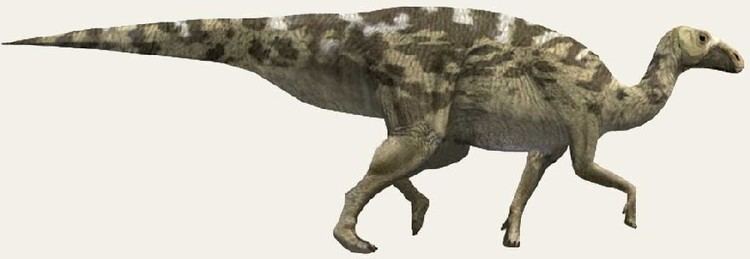Kingdom Animalia Clade Dinosauria Family †Hadrosauridae Scientific name Pararhabdodon isonensis Rank Species | Class Reptilia Suborder †Ornithopoda Tribe †Tsintaosaurini Phylum Chordata Order Ornithischia | |
 | ||
Similar Koutalisaurus, Arenysaurus, Aralosaurus, Telmatosaurus, Blasisaurus | ||
Pararhabdodon (meaning "similar to Rhabdodon" ["bar-tooth"]) is a genus of tsintaosaurin hadrosaurid dinosaur, from the Maastrichtian-age Upper Cretaceous Tremp Formation of Spain. It is based on assorted postcranial remains, mostly vertebrae, and is notable for the reassignments it has undergone in regard to classification.
Contents
History
In 1987, Casanovas et al. described remains of an ornithopod from Catalonia, including a cervical vertebra, some partial dorsals, a humerus, and a fragmentary scapula, as Rhabdodon sp. New remains from this site (Tremp Formation, near Isona, Lleida, Spain) brought about a reconsideration of the material, and Casanovas-Cladellas et al. named Pararhabdodon isonense in 1993 from a middle caudal vertebra (IPS-SRA-15), referring additional material to their new genus. At the time, it was considered to be a rhabdodont-like basal iguanodont, hence the name.
Additional material from the type locality was collected in 1994, and the species name was corrected to isonensis in 1997 by Casanovas-Cladellas et al. and Laurent et al. A dentary (IPS SRA 27) from a second quarry in the Tremp Formation was also referred to the genus, now considered to be a basal lambeosaurine hadrosaurid. Laurent et al. referred additional remains (jaw material, vertebrae, and limb bones of multiple individuals of different ages) from the uppermost Cretaceous of Aude, France, to the genus, but this was not discussed in the most recent review. (Oddly, the second edition of The Dinosauria omitted this genus altogether)
Head (2001) disputed the assignment to the Lambeosaurinae, considering it more likely to be basal to the two hadrosaurid subfamilies. This is the same conclusion that Prieto-Marquez et al. (2006) came to, finding it to be the sister group to Hadrosaurinae+Lambeosaurinae ( = Hadrosauridae in their analysis, although the definition of Hadrosauridae varies). Prieto-Márquez assigned IPS SRA 27 to its own genus, Koutalisaurus, a more derived hadrosaurid. More recent research by Prieto-Márquez and Wagner considers Koutalisaurus a probable synonym of Pararhabdodon, and Pararhabdodon a member of a lambeosaurine clade with the Chinese genus Tsintaosaurus.
Paleobiology
Pararhabdodon most likely was a bipedal-quadrupedal herbivore, in the neighborhood of 6 m (19.7 ft) long, fully grown. The dorsal and sacral neural spines were elongate, so the animal would have had a tall back, like other hadrosaurids. Because the material is sparse, more specific conclusions cannot be reached. Spanish material includes: a maxilla; four cervical, four dorsal, and a caudal vertebra; a sacrum; the end of an ischium; and a humerus.
